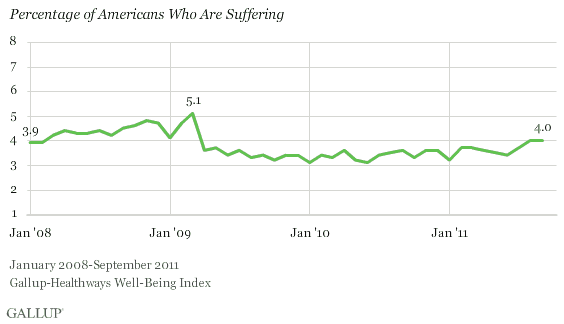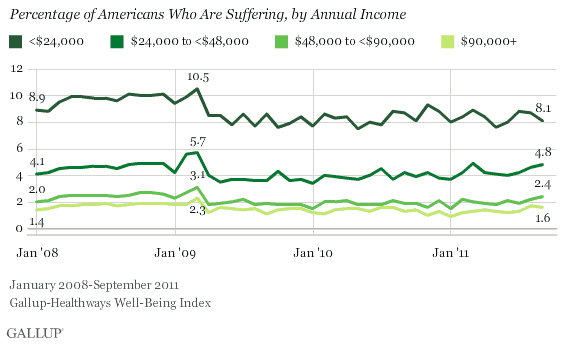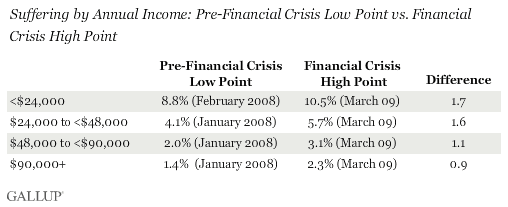WASHINGTON, D.C. -- Four percent of Americans rated their lives poorly enough to be considered suffering in September -- relatively little change from the past two and a half years.

While the 4% of Americans who are suffering is technically the highest since March 2009, it is not statistically higher than readings found since that time. This relative stability contrasts with the sharp spikes in suffering that Gallup has found in other nations embroiled in economic and political turmoil, including Greece.
Gallup classifies respondents as "thriving," "struggling," or "suffering," according to how they rate their current and future lives on a ladder scale with steps numbered from 0 to 10 based on the Cantril Self-Anchoring Striving Scale. People who rate their current life situation and their life in five years a 4 or less are considered suffering.
The percentage of Americans who are suffering is among the lowest in the world and is on par with other developed nations. Even low-income Americans are significantly less likely to be suffering than are entire populations in many parts of the globe, reflecting the higher standard of living U.S. citizens enjoy compared with those in other nations.
Greater Suffering at Lower Incomes
Suffering in the United States is now lower across all income groups compared with levels found in early 2009. However, low-income Americans are more than six times as likely as those with high incomes to be suffering -- 8.1% versus 1.6% in September. In general, suffering decreases as income increases.

High-income Americans also appear to be more insulated from severe economic downturns. While suffering increased across all income groups during the 2008 to 2009 financial crisis, it increased the most among low-income Americans.
The percentage of low-income Americans who were suffering rose to a high of 10.5% in March 2009, from a pre-financial crisis low of 8.8% in February 2008 -- an increase of 1.7 percentage points. Over the same time period, suffering increased to a lesser degree at each step up in income. It rose 1.6 percentage points among Americans with an income of $24,000 to less than $48,000 per year, 1.1 points for those with annual incomes of $48,000 to less than $90,000, and 0.9 points among those earning $90,000 or more per year.

Bottom Line
The life evaluation data provide a broad view of how Americans view their lives today and where they see their lives headed. The percentage of "suffering" Americans has been quite stable even as Americans' confidence in the economy has worsened, with increased percentages rating their financial situations as "poor" and saying their situations are getting worse.
Suffering could rise in the months ahead as Americans continue to hold such negative economic perceptions. But, based on the historical trend, it may take a financial crisis at least as bad as what happened in late 2008/early 2009 for suffering to rise significantly.
About the Gallup-Healthways Well-Being Index
The Gallup-Healthways Well-Being Index tracks U.S., U.K., and German wellbeing and provides best-in-class solutions for a healthier world. To learn more, please visit well-beingindex.com.
Survey Methods
Results are based on telephone interviews conducted as part of the Gallup-Healthways Well-Being Index survey Sept. 1-30, 2011, with a random sample of 29,313 adults, aged 18 and older, living in all 50 U.S. states and the District of Columbia, selected using random-digit-dial sampling.
Life evaluation Index figures from January 2008 to April 2009 reflect re-estimates calculated to address context effects that Gallup discovered after the data were originally published.
For results based on the total sample of national adults, one can say with 95% confidence that the maximum margin of sampling error is ±1 percentage point.
Interviews are conducted with respondents on landline telephones and cellular phones, with interviews conducted in Spanish for respondents who are primarily Spanish-speaking. Each sample includes a minimum quota of 400 cell phone respondents and 600 landline respondents per 1,000 national adults, with additional minimum quotas among landline respondents by region. Landline telephone numbers are chosen at random among listed telephone numbers. Cell phone numbers are selected using random-digit-dial methods. Landline respondents are chosen at random within each household on the basis of which member had the most recent birthday.
Samples are weighted by gender, age, race, Hispanic ethnicity, education, region, adults in the household, and phone status (cell phone only/landline only/both, cell phone mostly, and having an unlisted landline number). Demographic weighting targets are based on the March 2010 Current Population Survey figures for the aged 18 and older non-institutionalized population living in U.S. telephone households. All reported margins of sampling error include the computed design effects for weighting and sample design.
The Life Evaluation Index is based on the Cantril Self-Anchoring Striving Scale, which asks respondents to evaluate their present and future lives on a scale with steps numbered from 0 to 10, where "0" is the worst possible life and "10" is the best possible life. Those who rate today a "7" or higher and the future an "8" or higher are considered to be "thriving." Those who rate today and the future a "4" or lower on the scale are considered to be "suffering." The overall Life Evaluation Index score is calculated as the percentage of thriving Americans minus the percentage of suffering Americans.
In addition to sampling error, question wording and practical difficulties in conducting surveys can introduce error or bias into the findings of public opinion polls.
For more details on Gallup's polling methodology, visit www.gallup.com.
